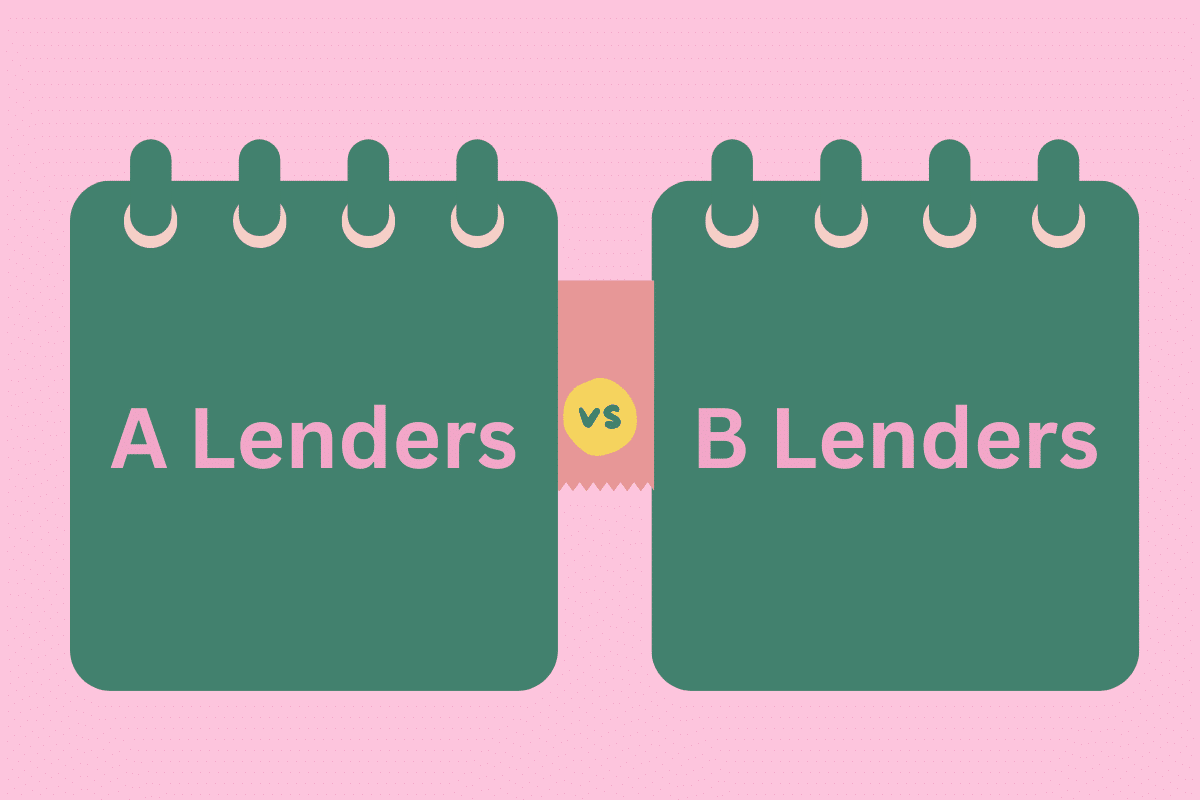A Lenders vs B Lenders in Canada: What are the differences?
By Larisa Ryabtseva | Published on 13 Jul 2023

Are you in the market for a personal loan, a car loan, or a mortgage? Are you familiar with the terms “A Lenders” and “B Lenders”? If not, don’t worry! In this article, we’ll outline the differences between A Lenders, who typically lends to people that are not a credit risk, and B Lenders, who typically lend to people that seem more risky to lend to.
The Role of A Lenders
A Lenders, often referred to as prime lenders, are the traditional financial institutions such as banks and credit unions. These institutions have a long history of providing loans to borrowers and are known for their strict lending criteria, such as a minimum credit score. A Lenders typically offer loans at competitive interest rates and are considered lower-risk lenders.
One of the reasons A Lenders are considered lower-risk is because they primarily serve borrowers with good credit scores and stable income. So if you are looking to get a loan from an A Lender, it’s generally a good idea to first check your credit score.
Additionally, A Lenders often require borrowers to provide collateral, such as property or other valuable assets, to secure the loan. These borrowers are seen as less likely to default on their loan repayments, which makes them attractive to A Lenders.
Due to their lower risk profile, A Lenders are able to offer borrowers more favorable loan terms, such as lower interest rates and longer repayment periods. This makes them a popular choice for individuals and businesses with strong financial profiles.
The Role of B Lenders
In contrast to A Lenders, B Lenders, also known as subprime lenders, cater to borrowers who may not meet the strict requirements of A Lenders. B Lenders focus on providing loans to individuals with lower credit scores or unique financial circumstances.
While B Lenders may charge higher interest rates to compensate for the higher risk involved, they offer more flexibility in terms of eligibility criteria. This means that borrowers who have been turned down by A Lenders may still have options with B Lenders.
B Lenders understand that not everyone fits into the traditional lending mold. They take into consideration factors beyond credit scores, such as employment history, income stability, and the borrower’s overall financial situation. This allows them to provide loans to individuals who may have experienced financial setbacks in the past but are now on a path to recovery, which is one of the reasons why subprime mortgages are popular in Canada.
| Types of Lenders | Types of Institutions | Average Interest Rate | Examples |
| A Lenders | Banks, Credit Unions | 5% – 15% | Scotiabank TD BMO RBC CIBC Vancity Desjardins |
| B Lenders | Private Lenders, Online Lenders, Mortgage Finance Companies, Car Dealerships, etc. | 9% – 47% | GoPeer Fairstone Car Loans Canada Magical Credit Home Trust MCAP |
Comparing A Lenders and B Lenders for Personal Loans
In the realm of personal loans, understanding the key differences between A Lenders and B Lenders is crucial for borrowers seeking financial assistance. In this part, we will talk about the variances in interest rates, repayment terms, eligibility criteria, and the types of lending institutions associated with each category. By exploring these factors, you can make informed decisions when considering personal loan options.
Interest Rates and Terms
One of the key factors to consider when comparing A Lenders and B Lenders for personal loans is the interest rates and terms offered by each. A Lenders generally provide loans at lower interest rates due to their lower risk profile, while B Lenders may charge higher rates to account for the increased risk they assume. Additionally, A Lenders often offer longer repayment terms, making monthly payments more affordable for borrowers.
Eligibility Criteria
When it comes to eligibility criteria, A Lenders have stricter requirements compared to B Lenders. A Lenders typically consider factors such as credit scores and assets. B Lenders, on the other hand, consider a broader range of factors beyond credit scores and may be more lenient towards borrowers with less-than-perfect credit histories in exchange for higher interest rates.
Types of institutions
In the Canadian personal loan space, various types of institutions engage in A lending and B lending to cater to different borrower needs. A lending is primarily offered by well-established financial institutions such as banks, credit unions, and other regulated lenders. On the other hand, B lending involves a different set of institutions such as private lenders, online lenders, and other specialized lending companies.
Comparing A Lenders and B Lenders for Mortgages
Canada’s major banks, namely RBC, TD, Scotiabank, BMO, CIBC and National Bank are the primary A Lenders for most mortgages in the country. Together, they account for 80% of the Canadian mortgage market and have an average 5-year fixed mortgage rate of 5.76%. While most mortgage loans in Canada are renegotiated every 5 years, it is important to note that the length required to pay off the entire loan is typically 25 years.
On the other hand, B Lenders, who account for less than 20% of the Canadian mortgage market, typically have an interest rate ranging from 6.5% to 15% with terms ranging from only 6 to 24 months. It is interesting to note that subprime mortgages account for 1 in 10 mortgages in Canada, and around 12% of Canadians are subprime borrowers. One example of B Lenders is Mortgage Finance Companies (MFCs), which accounted for only 4.39% of the Canadian mortgage market in 2021.
Comparing A Lenders and B Lenders for Car Loans
Vehicle financing options are available from different types of lenders and come in a wide variety of interest rates and loan terms. The interest rate for a car loan can vary between 6% and 9% for the average buyer. Several factors influence this rate, such as whether the car is new or used, the buyer’s credit score, the purchase price of the car, and whether the loan has a fixed or variable interest rate.
Banks and credit unions, known as A Lenders, offer financing with better interest rates but have higher car loan credit score requirements. However, borrowers with credit scores below 660 may struggle to get approved by these institutions.
Recently, B Lenders like Car Loans Canada have gained popularity among individuals with low credit scores. They are more lenient with credit score requirements, considering applicants with scores as low as 550. However, these lenders usually charge higher interest rates to offset the risk.
Car dealerships themselves often function as B Lenders when they offer in-house financing that allows you to make payments directly to them without applying for a separate loan. Dealerships work with multiple lenders to provide various financing options, including the attractive offer of zero-percent financing. This option, though, is usually available only to individuals with excellent credit scores. Typically, a minimum credit score of 700 is required to qualify for zero-percent financing, if it is offered at all.
The Bottom Line
When seeking personal loans, auto loans, or mortgages in Canada, understanding the differences between A Lenders and B Lenders is crucial. While A Lenders generally offer lower interest rates and stricter eligibility criteria, B Lenders provide more flexible options for individuals who may not qualify with traditional lenders. Consider your financial situation, credit history, and long-term goals when deciding which lender is right for you. Remember to explore multiple options, compare mortgages, interest rates and terms, and choose the lender that best aligns with your needs and financial circumstances.
